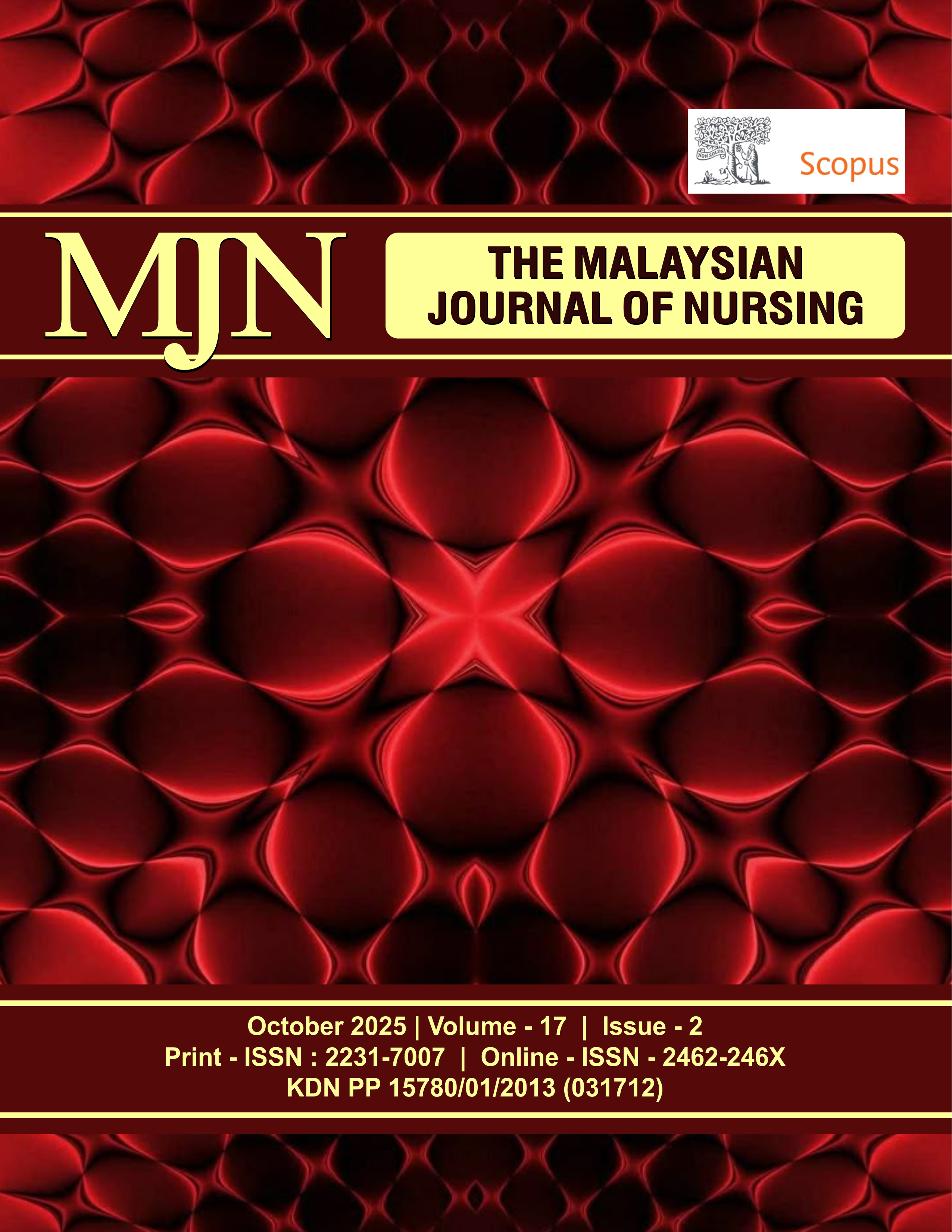Awareness and Evaluation of the Critical Care Pain Observation Tool (CPOT) Implementation among Critical Care Nurses in Teaching Hospital
DOI:
https://doi.org/10.31674/mjn.2025.v17i02.002Abstract
Background: Pain is subjective and unmeasurable. The gold standard for pain evaluation is self-reporting. Regrettably, pain often goes unrecognised in critically ill patients. Thus, a valid and reliable pain assessment tool is important to effectively assess pain level among critically ill patients. Objective: This study aims to identify the awareness and evaluation of the implementation of the Critical Care Pain Observation Tool (CPOT) among critical care nurses in Pusat Pakar Perubatan UiTM (PPUiTM), Malaysia. Methods: This quasi-experimental research utilised a one-group pretest-post-test design with total population sampling. Forty (40) critical care nurses from the Coronary Care Unit (CCU) or Cardiac Intensive Care Unit CICU, and Intensive Care Unit (ICU) units participated. The intervention involved training on CPOT usage. Pain awareness levels and CPOT evaluation were assessed using a validated questionnaire comprising demographic data, pain assessment awareness, and CPOT evaluation sections. Data were analysed using the Statistical Package for IBM Social Sciences (SPSS) version 27.0, with chi-square applied to assess pre- and post-intervention differences. Results: Most participants demonstrated poor pain awareness levels during the pre-test (70%), which significantly increased to 92.5% post-intervention. For the evaluation of CPOT, 77.5% of the participants would recommend using CPOT routinely in their practice. However, there are no significant associations between participant demographic data with the awareness of pain assessment and CPOT evaluation among participants for both pre- and post-tests, as the p-value recorded is >0.05. Conclusion: The interventions have effectively improved critical care nurses' understanding and awareness of critically ill patient pain assessment. The high rating of CPOT directive clarity indicates that the training provided to nurses for this study was successful.
Keywords:
Critical Care Pain Observation Tools, CPOT Evaluation, Nurses’ Pain Awareness, Pain in Critically Ill PatientsDownloads
References
Abdelmalik, M., Rahama, E., Abbakr, I., Hamed, A., Higazy, O., Mohammed, A., ... & Saeed, A. (2024). Nurses’ awareness and practice toward pain assessment and management as fifth vital sign in Sudan: A cross-sectional study. Sudan Journal of Medical Sciences, 19(2), 248-264. https://doi.org/10.18502/sjms.v19i2.12686
Afenigus A. D. (2024). Evaluating pain in non-verbal critical care patients: A narrative review of the critical care pain observation tool and its clinical applications. Frontiers in Pain Research (Lausanne, Switzerland), 5, 1481085. https://doi.org/10.3389/fpain.2024.1481085
Almutairi, A. M., Pandaan, I. N., Alsufyani, A. M., Almutiri, D. R., Alhindi, A. A., & Alhusseinan, K. S. (2022). Managing patients' pain in the intensive care units: Nurses' awareness of pain management. Saudi Medical Journal, 43(5), 514–521. https://doi.org/10.15537/smj.2022.43.5.20220169
Alotni, M. A., Sim, J., Chu, G., Guilhermino, M., Barker, D., Szwec, S., & Fernandez, R. (2025). Impact of implementing the critical-care pain observation tool in the adult intensive care unit: A nonrandomised stepped-wedge trial. Australian Critical Care: Official Journal of The Confederation of Australian Critical Care Nurses, 38(2), 101129. https://doi.org/10.1016/j.aucc.2024.09.014
Azhigul, A. (2020). Kazakhstani nurses’ knowledge of pain assessment and management in intensive care unit [Master’s thesis, Kajaani University of Applied Sciences]. Kajaani University Repository. https://www.theseus.fi/handle/10024/345425
Birhan, E. (2020). The practice of nurses and associated factors towards pain assessment in critically Ill adult patients in referral hospitals of Amhara Region, Ethiopia, 2019. Journal of Intensive and Critical Care, 6(4), 16. https://doi.org/10.36648/2471-8505.6.4.16
Boitor, M., Richard-Lalonde, M., Bérubé, M., Émilie, G., & Gélinas, C. (2019). Vital signs fluctuations and their relationship with pain in the brain-injured adult critically ill - A repeated-measures descriptive-correlational study. Intensive & Critical Care Nursing, 55, 102743. https://doi.org/10.1016/j.iccn.2019.07.002
Damico, V., Murano, L., Macchi, G., Forastieri Molinari, A., & Dal Molin, A. (2021). Knowledge and attitude of pain management among Italian nurses in intensive care unit: A multicentric descriptive study. Annali Di Igiene: Medicina Preventiva E Di Comunita, 33(3), 220–230. https://doi.org/10.7416/ai.2021.2429
Gélinas, C., Fillion, L., Puntillo, K. A., Viens, C., & Fortier, M. (2006). Critical-Care Pain Observation Tool (CPOT) [Database record]. APA PsycTests. https://doi.org/10.1037/t33641-000
Gélinas, C., Fillion, L., Puntillo, K. A., Viens, C., & Fortier, M. (2006). Validation of the critical-care pain observation tool in adult patients. American Journal of Critical Care, 15(4), 420-427. https://doi.org/10.4037/ajcc2006.15.4.420
Hamdan K. M. (2019). Nurses' assessment practices of pain among critically Ill patients. Pain Management Nursing: Official Journal of the American Society of Pain Management Nurses, 20(5), 489–496. https://doi.org/10.1016/j.pmn.2019.04.003
Idris, D.N.T., Kurnia, E., & Napitu, A. A. (2021) ‘Pain assessment using CPOT to patients with Ventilator’, European Journal of Molecular & Clinical Medicine, 8(2).
Innab, A., Alammar, K., Alqahtani, N., Aldawood, F., Kerari, A., & Alenezi, A. (2022). The impact of a 12-hour educational program on nurses' knowledge and attitudes regarding pain management: a quasi-experimental study. BMC Nursing, 21(1), 250. https://doi.org/10.1186/s12912-022-01028-4
International Association for the Study of Pain (IASP). (2020, July 16). IASP Announces Revised Definition of Pain. https://www.iasp-pain.org/publications/iasp-news/iasp-announces-revised-definition-of-pain/
Jamal, K., Alameri, R. A., Alqahtani, F. M., AlGarni, R. S., Alamri, N. A., Elshnawie, H. A., Badawi, S. E. A., & Hussien, A. M. (2023). Knowledge and attitudes of critical care nurses regarding pain management in Saudi Arabia. Medical Archives (Sarajevo, Bosnia and Herzegovina), 77(1), 49–55. https://doi.org/10.5455/medarh.2023.77.49-55
Kobayashi, N., Watanabe, K., Murakami, H., & Yamauchi, M. (2023). Continuous visualization and validation of pain in critically ill patients using artificial intelligence: A retrospective observational study. Scientific Reports, 13(1), 17479. https://doi.org/10.1038/s41598-023-44970-2
Kotfis, K., Zegan-Barańska, M., Szydłowski, Ł., Żukowski, M., & Ely, E. W. (2017). Methods of pain assessment in adult intensive care unit patients - Polish version of the CPOT (Critical Care Pain Observation Tool) and BPS (Behavioral Pain Scale). Anaesthesiology Intensive Therapy, 49(1), 66–72. https://doi.org/10.5603/AIT.2017.0010
Kouhi, F., Froutan, R., & Moghaddam, A. B. (2023). Investigating the effect of the CPOT-based pain management program on the pain intensity and dose adjustment of analgesics in mechanically ventilated patients: a randomized clinical trial. Nursing Practice Today, 10(3) https://doi.org/10.18502/npt.v10i3.13430
Lutz, R. M. (2020). Critical-care pain observation tool benchmark project (Master’s capstone project, University of Texas at Tyler). Scholar Works at UT Tyler. https://hdl.handle.net/10950/3797
Maatouk, H., Al Tassi, A., Fawaz, M. A., & Itani, M. S. (2019). Nurses' evaluation of critical care pain observation tool (CPOT) implementation for mechanically ventilated intensive care patients. Data in Brief, 25, 103997. https://doi.org/10.1016/j.dib.2019.103997
Modanloo, M., Mohsenpour, A., Rahmani, H., Moghaddam, S., & Khoddam, H. (2019). Impact of implementing the critical care pain observation tool on nurses' performance in assessing and managing pain in the critically Ill patients. Indian Journal of Critical Care Medicine: Peer-Reviewed, Official Publication of Indian Society of Critical Care Medicine, 23(4), 165–169. https://doi.org/10.5005/jp-journals-10071-23146
Nordness, M. F., Hayhurst, C. J., & Pandharipande, P. (2021). Current perspectives on the assessment and management of pain in the Intensive Care Unit. Journal of Pain Research, 14, 1733–1744. https://doi.org/10.2147/JPR.S256406
Ou, M., Xu, X., Chen, Y., Yan, Y., Wang, K., & Zhou, L. (2021). Factors related to nurses' knowledge and attitudes toward pain in hospitals in low-income areas. Pain Management Nursing: official journal of the American Society of Pain Management Nurses, 22(3), 386–393. https://doi.org/10.1016/j.pmn.2020.06.009
Phillips, M. L., Kuruvilla, V., & Bailey, M. (2019). Implementation of the critical care pain observation tool increases the frequency of pain assessment for noncommunicative ICU patients. Australian Critical Care: Official Journal of the Confederation of Australian Critical Care Nurses, 32(5), 367–372. https://doi.org/10.1016/j.aucc.2018.08.007
Pinheiro, A. R. P. D. Q., & Marques, R. M. D. (2020). Behavioral pain scale and critical care pain observation tool for pain evaluation in orotracheally tubed critical patients: A systematic review of the literature. Revista Brasileira de Terapia Intensiva, 31(4), 571-581. https://doi.org/10.5935/0103-507X.20190070
Rababa, M., Al-Sabbah, S., & Zahra, T. A. (2023). Importance of pain assessment, documentation, and education among nurses caring for critically Ill patients: A cross-sectional study. Electronic Journal of General Medicine, 20(5), em510. https://doi.org/10.29333/ejgm/13292
Rababa, M., Al-Sabbah, S., Eyadat, A. M., & Abusbaitan, H. A. (2023). the association between socio-demographic characteristics and using pain assessment tools among critically Ill patients. Medicina (Kaunas, Lithuania), 59(4), 759. https://doi.org/10.3390/medicina59040759
Rahman, M. A., Hanna, J., Zein, B. E., & Badr, L. K. (2022). A nonrandomized pretest post-test study on the impact of an educational pain management program on nurses' knowledge and attitudes regarding pain in a Middle Eastern Country. Pain Management Nursing: Official Journal of The American Society of Pain Management Nurses, 23(3), 324–329. https://doi.org/10.1016/j.pmn.2021.07.003
Sandvik, R. K. N. M., Mujakic, M., Haarklau, I., Emilie, G., & Moi, A. L. (2024). Improving pain management in the intensive care unit by assessment. Pain Management Nursing: Official Journal of the American Society of Pain Management Nurses, 25(6), 606–614. https://doi.org/10.1016/j.pmn.2024.06.013
Sedighie, L., Bolourchifard, F., Rassouli, M., & Zayeri, F. (2020). Effect of comprehensive pain management training program on awareness and attitude of ICU nurses. Anesthesiology and Pain Medicine, 10(2), e98679. https://doi.org/10.5812/aapm.98679
Siddiqui, A. S., Ahmed, A., Rehman, A., & Afshan, G. (2023). Pain assessment in intensive care units of a low-middle income country: Impact of the basic educational course. BMC Medical Education, 23(1), 567. https://doi.org/10.1186/s12909-023-04523-7
Sweity, E. M., Salahat, A. M., Sada, A. A., Aswad, A., Zabin, L. M., & Zyoud, S. E. H. (2022). Knowledge, attitude, practice and perceived barriers of nurses working in intensive care unit on pain management of critically ill patients: a cross-sectional study. BMC Nursing, 21(1), 202. https://doi.org/10.1186/s12912-022-00990-3
Ülgen, H., & Tüfekci, F. G. (2024). the effect of pain management education on nurses' pain knowledge and attitudes. Pain Management Nursing: official journal of the American Society of Pain Management Nurses, 25(3), e186–e191. https://doi.org/10.1016/j.pmn.2023.12.011
Yamakova, Y., Ivanova, M., Popova, M., Kurtelova, N., & Petkov, R. (2024). Quality improvement in an anaesthesiology and intensive care unit through pain assessment and control. Nigerian Journal of Clinical Practice, 27(5), 557–564. https://doi.org/10.4103/njcp.njcp_298_23
Zhai, Y., Cai, S., & Zhang, Y. (2020). the diagnostic accuracy of Critical Care Pain Observation Tool (CPOT) in ICU patients: A systematic review and meta-analysis. Journal of Pain and Symptom Management, 60(4), 847–856. e13. https://doi.org/10.1016/j.jpainsymman.2020.06.006
Published
How to Cite
Issue
Section
License
Copyright (c) 2025 The Malaysian Journal of Nursing (MJN)

This work is licensed under a Creative Commons Attribution-NonCommercial-NoDerivatives 4.0 International License.



































